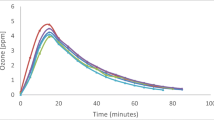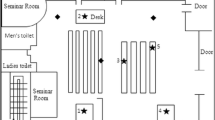Abstract
Public elevators are an essential requirement in modern high-rise buildings. However, the confined, crowded interior of an elevator provides an ideal breeding ground for all manners of biological aerosols. Consequently, when using an elevator at a university in Taiwan as the research target, this study performs an experimental investigation into the effectiveness of hand-sprayed gaseous chlorine dioxide as a disinfection agent. The air quality before and after disinfection is evaluated by measuring the bioaerosol concentrations of bacteria and fungi, respectively. The average background levels of bacteria and fungi before disinfection are found to be 635.7 ± 469.6 and 1296.8 ± 966.6 colony-forming unit (CFU)/m3, respectively. Following disinfection, the bacteria and fungi concentrations reduced by an average of 35 and 25 %, respectively. The multivariate analysis of variance (MANOVA) results showed that the residual bacteria and fungi concentration levels were determined primarily by the number of individuals within the elevator and the elapsed time following disinfection. In general, the present results show that given a maximum of five individuals within the elevator, a disinfection schedule of once every 40 min is sufficient to reduce the bioaerosol concentrations of bacteria and fungi to the levels specified by the Taiwan Environmental Protection Agency (EPA).


Similar content being viewed by others
References
ACGIH. (1986). Guidelines for assessment of bioaerosols in the indoor environment. Cincinnati: American Conference of Governmental Industrial Hygienists.
ACGIH. (1989). Guidelines for assessment of bioaerosols in the indoor environment. Cincinnati: American Conference of Governmental Industrial Hygienists.
Adhikari, A., Sen, M. M., Gupta-Bhattacharya, S., & Chanda, S. (2004). Volumetric assessment of airborne fungi in two sections of a rural indoor dairy cattle shed. Environment International, 29, 1071–1078.
AIHA. (1996). Field guide for the determination of biological contaminants in environmental samples. Fairfax: AIHA.
Buttner, M. P., Cruz-Perez, P., & Stetzenbach, L. D. (2001). Enhanced detection of surface-associated bacteria in indoor environments by quantitative PCR. Applied and Environmental Microbiology, 67, 2564–2570.
Canter, D. A., Gunning, D., Rodgers, P., O'Connor, L., Traunero, C., & Kempter, C. J. (2005). Remediation of Bacillus Anthracis contamination in the U.S. Department of Justice mail facility. Biosecurity and Bioterrorism, 3, 119–127.
Chen, Y. S., & Vaughn, J. M. (1990). Inactivation of human and simian rotaviruses by chlorine dioxide. Applied and Environmental Microbiology, 56, 1363–1366.
Cortezzo, D. E., Koziol-Dube, K., Setlow, B., & Setlow, P. (2004). Treatment with oxidizing agents damages the inner membrane of spores of Bacillus subtilis and sensitizes spores to subsequent stress. Applied and Environmental Microbiology, 97, 838–852.
Han, Y., Applegate, B., Linton, R. H., & Nelson, P. E. (2003). Decontamination of Bacillus thuringiensis spores on selected surfaces by chlorine dioxide gas. Journal of Environmental Health, 66, 16–21.
Hsu, C. S., & Huang, D. J. (2013). Disinfection efficiency of chlorine dioxide gas in student cafeterias in Taiwan. Journal of Air and Waste Management Association, 63, 796–805.
Hsu, C. S., Lu, M. C., & Huang, D. J. (2012). Application of chlorine dioxide for disinfection of student health centers. Environmental Monitoring and Assessment, 184, 741–747.
Huang, J. L., Wang, L., Ren, N. Q., Ma, F., & Juli. (1997). Disinfection effect of chlorine dioxide bacteria in water. Water Research, 33(3), 607–613.
Jeng, D. K., & Woodworth, A. G. (1990). Chlorine dioxide gas sterilization of oxygenators in an industrial scale sterilizer: a successful model. Artificial Organs, 14, 361–368.
Jones, A. M., & Harrison, R. M. (2004). The effects of meteorological factors on atmospheric bioaerosol concentrations. Science of the Total Environment, 326, 151–180.
Kabir, E., Kim, K. H., Sohn, J. R., Kweon, B. Y., & Shin, J. H. (2012). Indoor air quality assessment in child care and medical facilities in Korea. Environmental Monitoring and Assessment, 184, 6395–6409.
Kodama, A. M., & McGee, R. I. (1986). Airborne microbial contaminants in indoor environments, naturally ventilated and air conditioned homes. Archives of Environmental Health, 41, 306–311.
Lee, S. Y., Dancer, G. I., Chang, S. S., Rhee, M. S., & Kang, D. H. (2006). Efficacy of chlorine dioxide gas against Alicyclobacillus acidoterrestris spores on apple surfaces. International Journal of Food Microbiology, 108, 364–368.
Li, C. S., & Kuo, Y. M. (1992). Airborne characterization of fungi indoors and outdoors. Journal of Aerosol Science, 23(1), 667–670.
Lin, K. S., Hsieh, M. J., Liou, M. J., Liou, M. J., Lee, S. L., & Lai, C. K. (2007). Disinfection effect of chlorine dioxide on air quality control in Armed Forces General Hospital of Taiwan. Nature and Science, 5(4), 94–99.
Ling, I. M., Lu, M. C., & Hsu, C. S. (2008). Environmental quality improvement on indoor swimming pools by application of chlorine dioxide. Fresenius Environmental Bulletin, 17(8b), 1014–1021.
Loret, J. F., Robert, S., Thomas, V., Cooper, A. J., McCoy, W. F., & Levi, Y. (2005). Comparison of disinfectants for biofilm, protozoa and Legionella control. Journal of Water and Health, 3, 423–433.
Orsini, M., Laurent, i. P., Boninti, F., Arzani, D., & Ianni, A. (2002). A molecular typing approach for evaluating bioaerosol exposure in wastewater treatment plant workers. Water Research, 36, 1375–1378.
Sanchez, D. C., Mason, M., & Norris, C. (1987). Methods and results of characterization of organic emissions from indoor material. Atmospheric Environment, 21, 337–345.
Sivaganesan, M., Rice, E. W., & Marinas, B. J. (2003). A Bayesian method of estimating kinetic parameters for the inactivation of Cryptosporidium parvum oocysts with chlorine dioxide and ozone. Water Research, 37, 4533–4543.
Southwell, K. L. (2002). The use of chlorine dioxide as a mold treatment and its effect on paper acidity: a case study. The Journal of Academic Librarianship, 28, 400–405.
SPSS. (2003). SPSS Base 12.0 User's Guide. Chicago: SPSS Institute.
Stetzenbach, L. D. (2007). Manual of environmental microbiology. Washington D.C: ASM.
Sy, K., Murray, M. B., Harrison, M. D., & Beuchat, L. R. (2005). Evaluation of gaseous chlorine dioxide as a sanitizer for killing Salmonella, Escherichia coli O157: H7, Listeria monocytogenes, yeasts, and molds on fresh and fresh-cut produce. Journal of Food Protection, 68, 1176–1187.
Taiwan EPA (2008). Guidelines on environmental analysis laboratory EPA, Taiwan Environmental Protection Agency. http://www.niea.gov.tw/analysis/method/ListMethod.asp?methodtype=LIVE. Accessed 5 Dec 2012.
Taiwan EPA (2012). Guidelines on indoor air quality, Taiwan Environmental Protection Agency. http://www.indoorair.org.tw/. Accessed 5 Dec 2012.
Tsai, Y. M., & Liu, H. M. (2009). Exposure to culturable airborne bioaerosols during noodle manufacturing in central Taiwan. Science of the Total Environment, 407, 1536–1546.
Taylor, G. R., & Butler, M. (1982). A comparison of the virucidal properties of chlorine, chlorine dioxide, bromine chloride and iodine. The Journal of Hygiene (London), 89, 321–328.
US Department of Labor, Occupational Safety and Health Administration (2006). Occupational safety and health guideline for chlorine dioxide. http://www.osha.gov/SLTC/healthguidelines/chlorinedioxide/recognetion.html.
US EPA. (2000). Toxicological review of chlorine dioxide and chlorite (p. 6). Washington, DC: US Environmental Protection Agency. CAS Nos. 10049-04-4 and 7758-19-2.
US EPA. (2006). Technical evaluation report on evaluation of chlorine dioxide gas generator. Washington, DC: US Environmental Protection Agency.
US EPA. (2007). Pesticides: topical & chemical fact sheets-chlorine dioxide. Washington, DC: US Environmental Protection Agency.
Weaver-Meyers, P. L., Stolt, W. A., & Kowaleski, B. (1998). Controlling mold on library materials with chlorine dioxide: an eight-year case study. Journal of Academic Librarianship, 24, 455–458.
WHO. (2002). Guidelines for concentration and exposure–response measurements of fine and ultra fine particulate matter for use in epidemiological studies. Geneva: World Health Organization.
Young, S. B., & Setlow, P. (2003). Mechanisms of killing of Bacillus subtilis spores by hypochlorite and chlorine dioxide. Journal of Applied Microbiology, 95, 54–67.
Yu, B. F., Hu, Z. B., Liu, M., Yang, H. L., Kong, Q. X., & Liu, Y. H. (2009). Review of research on air-conditioning systems and indoor air quality control for human health. International Journal of Refrigeration, 32, 3–20.
Author information
Authors and Affiliations
Corresponding author
Rights and permissions
About this article
Cite this article
Hsu, CS., Huang, DJ. Evaluation and improvement of air quality in school public elevator. Environ Monit Assess 186, 2941–2948 (2014). https://doi.org/10.1007/s10661-013-3591-7
Received:
Accepted:
Published:
Issue Date:
DOI: https://doi.org/10.1007/s10661-013-3591-7




